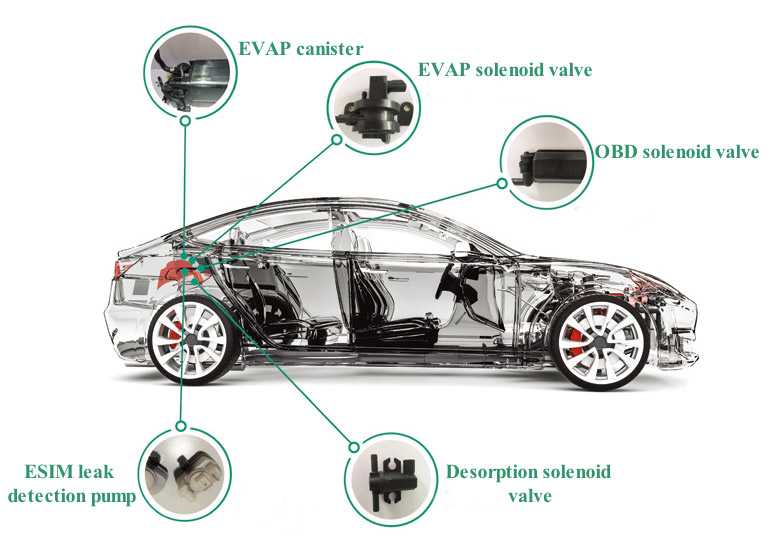
The fuel evaporation system is roughly composed of activated carbon canisters, drain control solenoid valves, fuel tank caps, steam separation valves, sensors and pipelines. The evaporation of gasoline at room temperature consists of two parts, fuel evaporative pollutants and refueling pollutants. Gasoline evaporative pollutants are recycled and reused through the EVAP system to meet the technical requirements of energy saving and environmental protection. No longer let these fuel vaporized pollutants be directly discharged into the atmosphere to pollute the air, but also can realize the reuse of waste, achieve the effect of energy saving and emission reduction.
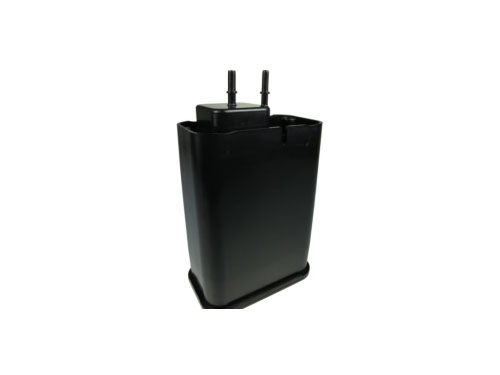
EVAP Canister
The vapor canister is one of the most important components in a vehicle’s evaporative emissions control system (EVAP), engineered to collect and retain fuel vapors emitted from the fuel tank. Filled with activated charcoal, it traps these vapors through adsorption, preventing their direct release into the air. During engine operation, the stored vapors are systematically routed to the combustion chamber, where they are incinerated, lowering pollutant output and enhancing fuel economy.
Opting for a durable replacement vapor canister is vital for consistent emissions management and system reliability. Inferior units may deteriorate prematurely, permitting vapor leakage, compromising efficiency, and elevating environmental contamination. A robust, precision-designed canister securely captures and retains vapors, ensuring adherence to emissions regulations while minimizing ecological impact. Selecting a superior replacement not only extends EVAP component longevity and optimizes fuel utilization but also promotes cleaner air.
1.Restores emissions compliance and enhances engine efficiency by securely containing and redirecting fuel vapors.
2.Utilizes high-grade activated carbon with a microporous structure, engineered for rapid adsorption and efficient desorption of hydrocarbon vapors.
3.Multi-layered architecture maximizes vapor distribution and surface contact, accelerating retention and reducing environmental emissions.
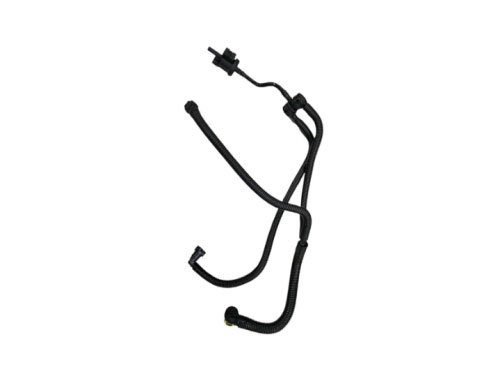
Vapor Canister Purge Valve Solenoid
The vapor canister purge solenoid plays a vital role in vehicle’s emissions control system by regulating the flow of fuel vapors stored in the carbon canister to the engine for combustion. This process prevents the release of harmful hydrocarbons into the environment, contributing to reduced air pollution and enhanced fuel efficiency. By ensuring precise vapor management, the solenoid helps vehicles comply with emissions regulations, promotes sustainable air quality, and minimizes ecological impact.
A high-performance replacement solenoid is crucial for maintaining optimal system functionality and emission compliance. Low-quality alternatives may result in operational failures, such as irregular engine performance, increased fuel consumption, or heightened pollutant output. A durable, precision-engineered solenoid safeguards consistent emissions control, improves fuel economy, and reduces strain on engine components. Selecting a reliable replacement not only extends engine longevity but also ensure vehicle reliability and environmental responsibility.
1.Ensures precise control of fuel vapor flow to maintain the ideal air-fuel ratio, enhancing combustion efficiency and overall engine power output.
2.Effectively traps and redirects fuel vapors from the carbon canister to the engine for combustion, minimizing hydrocarbon emissions and ensuring compliance with stringent environmental regulations .
3.Ensures precise operation with electromagnetic principles to control the flow of fuel vapors from the carbon canister to the engine.
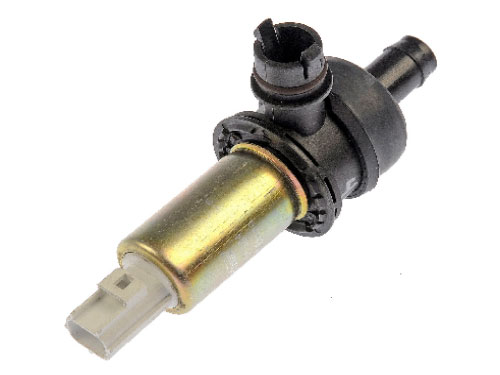
Vapor Canister Vent Valves
The vapor canister vent valve is a vital component in automotive emission control systems, designed to prevent the release of unburned fuel vapors into the atmosphere. It manages gasoline vapors stored in the fuel tank by channeling them into the engine’s combustion cycle, where they are safely combusted instead of escaping as pollutants. This process not only aligns with stringent emission regulations but also enhances air quality by curbing hydrocarbon discharges.
Opting for a durable aftermarket vent valve ensures sustained system integrity and regulatory alignment. Substandard components may compromise seal integrity, resulting in vapor seepage that exacerbates environmental contamination, diminishes fuel economy, and risks premature wear of adjacent emission-control modules over extended use.
1.Maintains EVAP system airtightness during OBD II diagnostics (typically open for standard operation), enabling accurate leak detection and compliance verification.
2.Equipped with a built-in filtration mechanism to trap debris and airborne particles, mitigating blockages and sustaining unimpeded airflow to the vapor recovery system.
3.Adaptive actuation aligns with real-time engine conditions, facilitating rapid vapor evacuation to stabilize combustion dynamics and enhance operational efficiency.
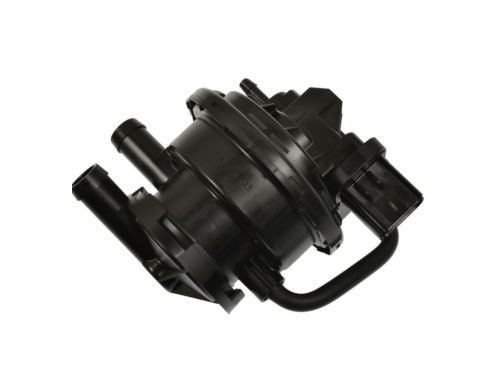
Leak Detection Pump
The leak detection pump is a critical part of a vehicle’s evaporative emissions control system (EVAP) , tasked with detecting and alerting fuel vapor leaks. By pressurizing the system and detecting pressure losses, it ensures fuel vapors are safely directed to the engine for combustion rather than released into the environment. This mechanism is key to meeting emissions regulations and minimizing ecological harm caused by hydrocarbon pollution.
A reliable replacement leak detection pump is essential for optimal vehicle performance and environmental sustainability. Substandard pumps may fail to identify leaks effectively, resulting in persistent emissions and potential activation of error alerts. Choosing a durable, precision-engineered pump guarantees compliance with emissions standards, improves fuel economy, and prevents premature wear on EVAP system parts. A high-grade replacement safeguards air quality, enhances operational reliability, and supports long-term vehicle health.
1.Ensures leak-free EVAP system operation by precisely identifying vapor leaks, preventing harmful hydrocarbon emissions.
2.Engineered to generate calibrated vacuum levels for pinpoint leak diagnostics, optimizing emissions control and engine efficiency.
3.Features real-time pressure tracking via integrated sensors, enabling swift identification of system irregularities.



